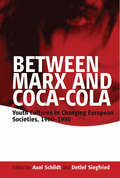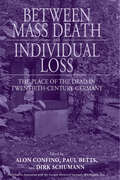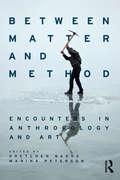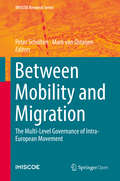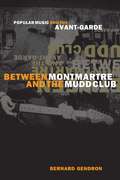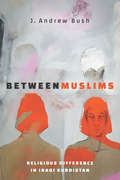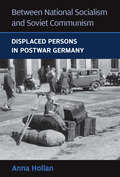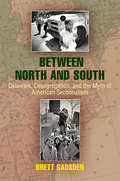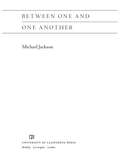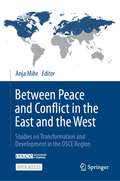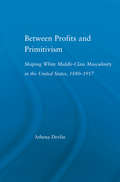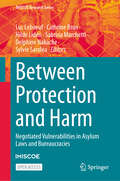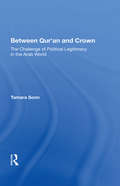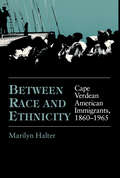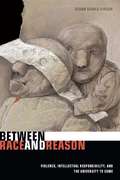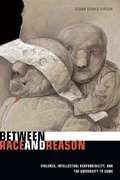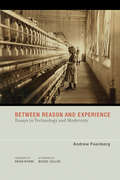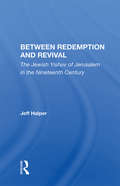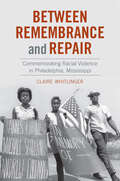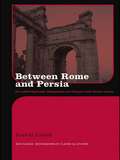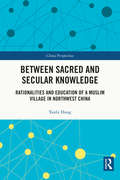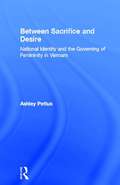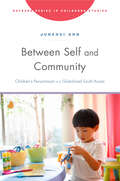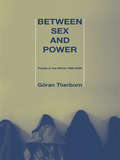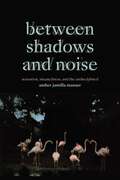- Table View
- List View
Between Marx and Coca-Cola
by Axel Schildt Detlef SiegfriedIn the 1960s and 1970s, Western Europe's "Golden Age" (Eric Hobsbawm), a new youth consciousness emerged, which gave this period its distinctive character. Offering rich and new material, this volume moves beyond the easy conflation of youth culture and "Americanization" and instead sets out to show, for the first time, how international developments fused with national traditions to produce specific youth cultures that became the leading trendsetters of emergent post-industrial Western societies. It presents a multi-faceted portrait of European youth cultures, colored by differences in gender, class, and education, and points out the tension between emerging consumerism and growing politicisation, succinctly expressed by Jean-Luc Godard in his 1967 pairing of "Marx and Coca-Cola. "
Between Mass Death And Individual Loss
by Dirk Schumann Paul Betts Alon ConfinoRecent years have witnessed growing scholarly interest in the history of death. Increasing academic attention toward death as a historical subject in its own right is very much linked to its pre-eminent place in 20th-century history, and Germany, predictably, occupies a special place in these inquiries. This collection of essays explores how German mourning changed over the 20th century in different contexts, with a particular view to how death was linked to larger issues of social order and cultural self-understanding. It contributes to a history of death in 20th-century Germany that does not begin and end with the Third Reich.
Between Matter and Method: Encounters In Anthropology and Art
by Gretchen Bakke; Marina PetersonBuilding on the lively exchange between anthropology and art that has emerged in recent years, Between Matter and Method makes a bold and creative contribution to this rapidly growing field. Taking an expansive approach to the arts, it finds commonalities in approaches that engage with visual artifacts, sound, performance, improvisation, literature, dance, theater, and design. The book questions current disciplinary boundaries and offers a new model grounded in a shared methodology for interdisciplinary encounter between art and anthropology. Gretchen Bakke and Marina Peterson have gathered together anthropologists whose work is notable for engaging the arts and creative practice in conceptually rigorous and methodologically innovative ways, including Kathleen Stewart, Keith Murphy, Natasha Myers, Stuart McLean, Craig Campbell, and Roger Sansi. Essays span the globe from Indonesia, West Virginia and Los Angeles in the United States, to the Orkney Islands in the UK, and Russia and Spain.
Between Mobility and Migration: The Multi-Level Governance of Intra-European Movement (IMISCOE Research Series)
by Peter Scholten Mark Van OstaijenThis open access book offers a critical perspective on intra-European mobility and migration by using new empirical data and theoretical discussions. It develops a theoretical and empirical analysis of the consequences of intra-European movement for sending and receiving urban regions in The Netherlands, Sweden, Austria, Turkey, Poland and Czech Republic. The book conceptualizes Central and Eastern European (CEE) migration by distinguishing between different types of CEE migrants and consequences. This involves a mapping of migration corridors within Europe, a unique empirical analysis of consequences for urban regions, and an analysis of governance responses. Next to the European and country perspectives on this phenomenon, the book focuses on the local perspective of urban regions where most mobile citizens settle (either permanently or temporarily). This way the book puts the analysis of intra-European movement in the perspective of broader theoretical debates in migration studies and beyond.
Between Montmartre and the Mudd Club: Popular Music and the Avant-Garde
by Bernard GendronDuring the late nineteenth and early twentieth century, popular music was considered nothing but vulgar entertainment. Today, jazz and rock music are seen as forms of art, and their practitioners are regularly accorded a status on par with the cultural and political elite. To take just one recent example, Bono, lead singer and lyricist of the rock band U2, got equal and sometimes higher billing than Pope John Paul II on their shared efforts in the Jubilee 2000 debt-relief project. When and how did popular music earn so much cultural capital? To find out, Bernard Gendron investigates five key historical moments when popular music and avant-garde art transgressed the rigid boundaries separating high and low culture to form friendly alliances. He begins at the end of the nineteenth century in Paris's Montmartre district, where cabarets showcased popular music alongside poetry readings in spaces decorated with modernist art works. Two decades later, Parisian poets and musicians "slumming" in jazz clubs assimilated jazz's aesthetics in their performances and compositions. In the bebop revolution in mid-1940s America, jazz returned the compliment by absorbing modernist devices and postures, in effect transforming itself into an avant-garde art form. Mid-1960s rock music, under the leadership of the Beatles, went from being reviled as vulgar music to being acclaimed as a cutting-edge art form. Finally, Gendron takes us to the Mudd Club in the late 1970s, where New York punk and new wave rockers were setting the aesthetic agenda for a new generation of artists.Between Montmartre and the Mudd Club should be on the shelves of anyone interested in the intersections between high and low culture, art and music, or history and aesthetics.
Between Muslims: Religious Difference in Iraqi Kurdistan (Stanford Studies in Middle Eastern and Islamic Societies and Cultures)
by J. Andrew BushWithin the broad contours of Islamic traditions, Muslims are enjoined to fast during the month of Ramadan, they are invited to a disciplined practice of prayer, and they are offered the Quran as the divine revelation in the most beautiful verbal form. But what happens if Muslims choose not to fast, or give up prayer, or if the Quran's beauty seems inaccessible? When Muslims do not take up the path of piety, what happens to their relationships with more devout Muslims who are neighbors, friends, and kin? Between Muslims provides an ethnographic account of Iraqi Kurdish Muslims who turn away from devotional piety yet remain intimately engaged with Islamic traditions and with other Muslims. Andrew Bush offers a new way to understand religious difference in Islam, rejecting simple stereotypes about ethnic or sectarian identities. Integrating textual analysis of poetry, sermons, and Islamic history into accounts of everyday life in Iraqi Kurdistan, Between Muslims illuminates the interplay of attraction and aversion to Islam among ordinary Muslims.
Between National Socialism and Soviet Communism: Displaced Persons in Soviet Germany
by Anna HolianAlso of Interest
Between North and South
by Brett GadsdenBetween North and South chronicles the three-decade-long struggle over segregated schooling in Delaware, a key border state and important site of civil rights activism and white reaction. Historian Brett Gadsden begins by tracing the origins of a long litigation campaign by NAACP attorneys who translated popular complaints about the inequities in Jim Crow schooling into challenges to racial proscriptions in public education. Their legal victories subsequently provided the evidentiary basis for the Supreme Court's historic decision in Brown v. Board of Education, marking Delaware as a center of civil rights advancements. Gadsden's further examination of a novel metropolitan approach to address the problem of segregation in city and suburban schools, wherein proponents highlighted the web of state-sponsored discrimination that produced interrelated school and residential segregation, reveals the strategic creativity of civil rights activists. He shows us how, even in the face of concerted white opposition, these activists continued to advance civil rights reforms into the 1970s, secured one of the most progressive busing remedies in the nation, and created a potential model for desegregation efforts across the United States.Between North and South also explores how activists on both sides of the contest in this border state--adjacent to the Mason-Dixon line--helped create, perpetuate, and contest ideas of southern exceptionalism and northern innocence. Gadsden offers instead a new framework in which "southern-style" and "northern-style" modes of racial segregation and discrimination are revealed largely as regional myths that civil rights activists and opponents alternately evoked and strategically deployed to both advance and thwart reform.
Between One and One Another
by Michael JacksonMichael Jackson extends his path-breaking work in existential anthropology by focusing on the interplay between two modes of human existence: that of participating in other peoples' lives and that of turning inward to one's self. Grounding his discussion in the subtle shifts between being acted upon and taking action, Jackson shows how the historical complexities and particularities found in human interactions reveal the dilemmas, conflicts, cares, and concerns that shape all of our lives. Through portraits of individuals encountered in the course of his travels, including friends and family, and anthropological fieldwork pursued over many years in such places as Sierra Leone and Australia, Jackson explores variations on this theme. As he describes the ways we address and negotiate the vexed relationships between "I" and "we"--the one and the many--he is also led to consider the place of thought in human life.
Between Peace and Conflict in the East and the West: Studies on Transformation and Development in the OSCE Region
by Anja MihrThis open access book features various studies on democratization, transformation, socio-economic development, and security issues in the Organization for Security and Cooperation in Europe (OSCE) geographical region and beyond. Written by experts and scholars working in the field of human dimension, security, transformation and development in Europe and Asia, particularly in post-soviet and communist countries, it examines the connectivity that the OSCE provides between the East and the West.The 2021 edition of this Compilation Series of the OSCE Academy presents studies on peace and conflict as well as political regime development in various member states of the OSCE as well as their economic, security and human rights performance and the challenges countries and society face currently. The OSCE is working in promoting Human Rights and Democratization under the notion of Human Dimension of ODIHR and is enhancing securitization and development policies in Eurasia, Europe, Central Asia and North America since 1991. 2021 marks the 30th anniversary on the tremendous efforts in promoting democracy, security and development. This compilation reviews some of these efforts in light of this anniversary, the achievements and shortcomings.
Between Profits and Primitivism: Shaping White Middle-Class Masculinity in the U.S., 1880-1917 (Literary Criticism and Cultural Theory)
by Athena DevlinBetween 1800 and the First World War, white middle-class men were depicted various forms of literature as weak and nervous. This book explores cultural writings dedicated to the physical and mental health of the male subject, showing that men have mobilized gender constructions repeatedly and self-consciously to position themselves within the culture. Aiming to join those who offer nuanced accounts of masculinity, Devlin investigates the various and changing interests white manhood was positioned to cultivate and the ways elite white men used "their own," so to speak, to promote larger agendas for their class and race.
Between Protection and Harm: Negotiated Vulnerabilities in Asylum Laws and Bureaucracies (IMISCOE Research Series)
by Luc Leboeuf Cathrine Brun Hilde Lidén Sabrina Marchetti Delphine Nakache Sylvie SaroleaThis open access book dissects the current narratives of ‘vulnerability’ in asylum laws and policies, by unpacking the meanings, productions, and performances, of ‘vulnerability’ in different contexts, from countries of first asylum in the Global South to Europe and Canada. It discusses how the increased reliance on ‘vulnerability’ to guide states’ replies to refugee movements improves refugee protection, while also generating contestations and exclusionary effects that may cause harm. Based on data collected as part of the EU Horizon 2020 VULNER project, the book examines existing legal and bureaucratic approaches to refugees’ vulnerabilities, which it confronts with the refugees’ experiences and understandings of their own life challenges. It analyses the perspectives from state actors, humanitarian organisations, and social and aid workers, as well as the refugees themselves. By emphasizing how these perspectives relate and feed into each other, the book unpacks the humanitarian replies from states and the international community to refugee movements – including in their implied exclusionary dimensions that generate contestations and implementation difficulties which, if not tackled and understood properly, risk exacerbating and/or producing vulnerabilities among refugees.
Between Qur'an And Crown: The Challenge Of Political Legitimacy In The Arab World
by Tamara SonnThe struggle for political legitimacy in many Middle Eastern countries today poses a dilemma for ruling elites. In order to maintain authority, leaders often must capitulate to Islamic universalist dogma, which may conflict with their own views of the state as well as threaten the legitimacy of other leaders in the region who are attempting to establish a secular, national basis for government. Tracing the roots of this dilemma in Middle Eastern history and Islamic philosophy, Dr. Sonn compares the contemporary Middle Eastern period to Europe’s “Age of Religious Wars†that preceded the emergence of the Western secular state. She describes how a process similar to the organic development of the secular state in Europe was interrupted in the Middle East by oppressive Western colonialism, which eventually led to the Muslim rejection of nationalism and all things “Western†and to the reassertion of Islam as the sole source of political legitimacy. The author shows how the philosophy of Islamic traditionalism opposes the two fundamentals of stable national political systems—a geographical limitation of authority and an institutionalized process for regular changes in leadership. Dr. Sonn bases her argument on an insightful examination of Middle Eastern history, from the formation and disintegration of the Ottoman Empire in the late nineteenth century to the present, and caps it with a detailed look at a possible solution to the dilemma: the teachings of modern scholars who advocate a new “Islamic realism†incorporating a limited definition of national identity and interests while retaining Islamic social goals.
Between Race and Ethnicity: Cape Verdean American Immigrants, 1860-1965 (Statue of Liberty Ellis Island)
by Marilyn HalterArriving in New England first as crew members of whaling vessels, Afro-Portuguese immigrants from Cape Verde later came as permanent settlers and took work in the cranberry industry, on the docks, and as domestic workers. Marilyn Halter combines oral history with analyses of ships' records to chart the history and adaptation patterns of the Cape Verdean Americans. Though identifying themselves in ethnic terms, Cape Verdeans found that their African-European ancestry led their new society to view them as a racial group. Halter emphasizes racial and ethnic identity formation to show how Cape Verdeans set themselves apart from the African Americans while attempting to shrug off white society's exclusionary tactics. She also contrasts rural life on the bogs of Cape Cod with New Bedford’s urban community to reveal the ways immigrants established their own social and religious groups as they strove to maintain their Crioulo customs.
Between Race and Reason: Violence, Intellectual Responsibility, and the University to Come
by Susan Searls GirouxGiroux (English and cultural studies, McMaster U., Canada) interrogates the role of the university in the United States in the post-civil rights area in complicity and collusion with racially motivated and legitimated economic exploitation and violence, challenging what she terms the "raceless racism" perpetuated in law, the economy, and militarism and placing her discussion within the context of wider critiques of the neoliberalization of higher education and intellectual justifications for racism and war. She also considers ways in which the university can be reconceived such that it may serve as a counter to racially-based violence and injustice. In conducting this discussion she engages with a wide array of thinkers, including Martin Luther King Jr., W. E. B. Du Bois, Friedrich Nietzsche, Michel Foucault, and Jacques Derrida. Annotation ©2011 Book News, Inc., Portland, OR (booknews.com)
Between Race and Reason: Violence, Intellectual Responsibility, and the University to Come
by Susan Searls GirouxInquiring into the future of the university, Susan Giroux finds a paradox at the very heart of thinking about higher education in the post-civil rights era. Giroux argues that our present is shaped by "raceless" racism at home and permanent civilizational war abroad.
Between Reason and Experience: Essays in Technology and Modernity (Inside Technology)
by Andrew FeenbergA leading philosopher of technology calls for the democratic coordination of technical rationality with everyday experience.The technologies, markets, and administrations of today's knowledge society are in crisis. We face recurring disasters in every domain: climate change, energy shortages, economic meltdown. The system is broken, despite everything the technocrats claim to know about science, technology, and economics. These problems are exacerbated by the fact that today powerful technologies have unforeseen effects that disrupt everyday life; the new masters of technology are not restrained by the lessons of experience, and accelerate change to the point where society is in constant turmoil. In Between Reason and Experience, leading philosopher of technology Andrew Feenberg makes a case for the interdependence of reason—scientific knowledge, technical rationality—and experience. Feenberg examines different aspects of the tangled relationship between technology and society from the perspective of critical theory of technology, an approach he has pioneered over the past twenty years. Feenberg points to two examples of democratic interventions into technology: the Internet (in which user initiative has influenced design) and the environmental movement (in which science coordinates with protest and policy). He examines methodological applications of critical theory of technology to the case of the French Minitel computing network and to the relationship between national culture and technology in Japan. Finally, Feenberg considers the philosophies of technology of Heidegger, Habermas, Latour, and Marcuse. The gradual extension of democracy into the technical sphere, Feenberg argues, is one of the great political transformations of our time.
Between Redemption And Revival: The Jewish Yishuv Of Jerusalem In The Nineteenth Century
by Jeff HalperIn the Zionist view of Israeli history, the Old Yishuv of Jerusalem - the Jewish community of the 19th and early 20th centuries - was "a lifeless body ruled by hypocrites, cheats and unschooled rabbis", and its importance was downplayed and ignored in this study of the Old Yishuv, Dr Halper uncovers the personalities, issues, and events that formed
Between Remembrance and Repair: Commemorating Racial Violence in Philadelphia, Mississippi
by Claire WhitlingerFew places are more notorious for civil rights–era violence than Philadelphia, Mississippi, the site of the 1964 "Mississippi Burning" murders. Yet in a striking turn of events, Philadelphia has become a beacon in Mississippi's racial reckoning in the decades since. Claire Whitlinger investigates how this community came to acknowledge its past, offering significant insight into the social impacts of commemoration. Examining two commemorations around key anniversaries of the murders held in 1989 and 2004, Whitlinger shows the differences in how those events unfolded. She also charts how the 2004 commemoration offered a springboard for the trial of former Klan leader Edgar Ray Killen for his role in the 1964 murders, the 2006 passage of Mississippi's Civil Rights/Human Rights education bill, and the initiation of the Mississippi Truth Project. In doing so, Whitlinger provides the first comprehensive account of these high profile events and expands our understanding of how commemorations both emerge out of and catalyze associated memory movements. Threading a compelling story with theoretical insights, Whitlinger delivers a study that will help scholars, students, and activists alike better understand the dynamics of commemorating difficult pasts, commemorative practices in general, and the links between memory, race, and social change.
Between Rome and Persia: The Middle Euphrates, Mesopotamia and Palmyra under Roman control
by Peter EdwellThis detailed history of explores Rome’s interaction with its Persian neighbour and enemy from the first century BC to the third century AD. Peter Edwell takes the innovative approach in treating the area in regional terms, giving more nuanced interpretations than are available in broader treatments of the Roman Near East.
Between Sacred and Secular Knowledge: Rationalities and Education of a Muslim Village in Northwest China (China Perspectives)
by Yanbi HongThis book examines how different social forces, including state ideology and policies, religious culture and ethnic identities, and economic market forces, affect Muslim parents’ perceptions and attitudes toward public and religious education. Combining ethnographic fieldwork and a cognitive rationality framework, this book investigates ethnic minorities’ educational attainment and its shaping mechanisms. Instead of attributing the undereducation of ethnic minorities solely to structural factors such as economic constraints, cultural conflicts and state policies, this study focuses on the critical role of perceptions and expectations through which many structural factors function. The fieldwork in a predominantly Muslim village in northwest China reveals that public education and religious education are complementary in the daily pursuit of well-being. And the study further argues that the practical oriented logic of rural Muslims sheds light on the research of inequality in educational attainment. The book will be of interest to scholars and postgraduate students studying ethnic minority education in China. Those who are researching on Islam and Muslims’ identity, especially in a multiethnic society, may also find this research insightful and helpful.
Between Sacrifice and Desire: National Identity and the Governing of Femininity in Vietnam
by Ashley PettusThis title explores the role of women in the politics of national identity in Vietnam. Drawing on diverse primary resources--including state news media, government contests, tabloid journalism, and extensive interviews--the author examines the intimate connection between notions of Vietnamese femininity and the cultural quandaries of modernity in post-colonial Vietnam. The book covers the socialist and market reform periods (from the 1950s through the 1990s) and examines women's central place--as both symbols and disciplined subjects--in Vietnam's socialist modernization and ongoing capitalist transition.
Between Self and Community: Children’s Personhood in a Globalized South Korea (Rutgers Series in Childhood Studies)
by Junehui AhnBetween Self and Community investigates the early childhood socialization process in a rapidly changing, globalizing South Korea. Based on long-term ethnographic fieldwork in a South Korean preschool, it shows how both children and teachers interactively navigate, construct, and reconstruct their own multifaceted and sometimes conflicting models of what makes “a good child” amid Korea’s shifting educational and social contexts. Junehui Ahn details the conflicting and competing ways in which the ideologies of new personhood are enacted in actual everyday socialization contexts and reveals the confusions, dilemmas, and ruptures that occur when globally dominant ideals of childhood development are superimposed onto local experiences. Between Self and Community pays special attention to the way children, as active agents of socialization, create, construe, and sustain their own meanings of their personhood, thereby highlighting the dynamism children and their culturally rich peer world create in South Korea’s shifting socialization terrain.
Between Sex and Power: Family in the World 1900-2000 (International Library of Sociology)
by Göran TherbornThe institution of the family changed hugely during the course of the twentieth century. In this major new work, Göran Therborn provides a global history and sociology of the family as an institution and of politics within the family, focusing on three dimensions of family relations: on the rights and powers of fathers and husbands; on marriage, cohabitation and extra-marital sexuality; and on population policy. Therborn's empirical analysis uses a multi-disciplinary approach to show how the major family systems of the world have been formed and developed. Therborn concludes by assessing what changes the family might see during the next century.This book will be essential reading for anybody with an interest in either the sociology or the history of the family.
Between Shadows and Noise: Sensation, Situatedness, and the Undisciplined
by Amber Jamilla MusserIn Between Shadows and Noise Amber Jamilla Musser theorizes sensation as a Black feminist method for aesthetic interpretation and criticism that uses the knowledges held by the body to access the unrepresentable. Thinking through Blackness, empire, and colonialism, Musser examines artworks ranging from Ming Smith’s Flamingo Fandango, Jordan Peele’s Us, and Katherine Dunham’s Shango to Samita Sinha’s This ember state, Titus Kaphar’s A Pillow for Fragile Fictions, and Teresita Fernández’s Puerto Rico (Burned) 6. She engages with these works from an embodied situatedness to grapple with the questions and sensations of racialization and difference that the works produce. Throughout, Musser rethinks how we consider the relationships between race, representation, and politics by dwelling in those spaces and concepts that elude Western norms of representation, objectivity, and logic. In so doing, she explores ways of being and knowing that exceed overdetermined parameters while offering a blueprint for sensing, imagining, and living otherwise.
